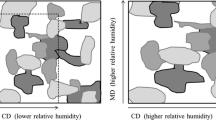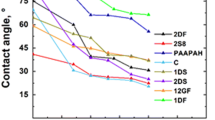Abstract
Mechanical properties of the electro-active paper (EAPap) actuator were tested to investigate its hygrothermal behavior. Tensile creep behavior was studied with constant load at 30–70% relative humidity ranges and 25–40°C temperature. Creep deformation showed typical trend of abrupt strain increase in a short period followed by steady increase of strain, which resulted from the breakdown of cellulose microfibrils. Dependence on the material orientation of EAPap was observed in the creep tests. As changing the orientation of EAPap samples, the creep resistances were varied. Creep strains and creep strain rates were increased as increasing the relative humidity level at 25°C. However, at the elevated temperature of 40°C, the creep strain rate at secondary creep was not significantly raised under increased relative humidity level from 30% to 50%. The hygrothermal effect by increasing the relative humidity level and temperature on the creep rate was reduced due to the saturated moisture at a higher temperature even with lower humidity level. The activation energy levels for creep were around 607–658 kJ/mol for 30% relative humidity level and 623–671 kJ/mol for 50% relative humidity level depending on the material orientation. Understanding of hygrothermal effect in conjunction with the humidity and temperature provides useful information for the potential nano-bio applications of the EAPap actuator.
Similar content being viewed by others
References
Y. Bar-Cohen, Electroactive Polymer (EAP) Actuators as Artificial Muscles: Reality, Potential, and Challenges, SPIE Press, Bellingham, WA, (2001).
J. Kim and Y. Seo, Electro-active paper actuators, Smart Material and Structures, 11(3) (2002) 355–360.
Y. Nishiyama, J. Sugiyama, H. Chanzy and P. Langan, Crystal Structure and Hydrogen Bonding System in Cellulose I from Synchrotron X-ray and Neutron Fiber Diffraction, Journal of the American Chemical Society, 125(47) (2003) 14300–14306.
Y. Nishiyama, H. Chanzy and P. Langan, Crystal Structure and Hydrogen-Bonding System in Cellulose Ib from Synchrotron X-ray and Neutron Fiber Diffraction, Journal of the American Chemical Society, 124(31) (2002) 9074–9082.
W. Hamadod, Cellulosic Materials Fibers, Networks and Composites, Kluwer Academic Publishers, Norwell, MA, (2002).
J. Kim, S. Yun and Z. Ounaies, Discovery of Cellulose as a Smart Material, Macromolecules, 39(12) (2006) 4202–4206.
S. Yun, J. Kim and C. Song, Performance of Electro-active paper actuators with thickness variation, Sensors and Actuators A: Physical, 133(1) (2007) 225–230.
J. Kim, C. S. Song and S. Yun, Cellulose based electro-active papers: performance and environmental effects, Smart Materials and Structures, 15(3) (2006) 719–723.
J. Kim, Y. Kang and S. Yun, Force measurement of electro-active paper actuators by micro-balance, Sensors and Actuators A: Physical, 133(2) (2007) 401–406.
G. Y. Yun, H. S. Kim and J. Kim, Blocked Force Measurement of Electro-Active Paper Actuator Using Cantilevered Force Transducer, Smart Materials and Structures, 17(2) (2008).
J. Kim, W. Jung and H. S. Kim, In-plane Strain of Electro-Active Papers Under Electric Fields, Sensors and Actuators A: Physical, 140(2) (2007) 225–231.
G. Y. Yun, H. S. Kim, J. Kim, K. Kim and C. Yang, Effect of Aligned Cellulose Film to the Performance of Electro-Active Paper Actuator, Sensors and Actuators A: Physical, 141(2) (2008) 530–535.
J. Kim, S. Y. Yang, K. Song, S. Jones and S. Choi, Performance Characterization of Flexible Dipole Rectennas for Smart Actuators, Smart Materials and Structures, 15(3) (2006) 809–815.
J. Kim, S. H. Bae and H. Lim, Micro transfer printing on cellulose electro-active papers, Smart Materials and Structures, 15(3) (2006) 889–892.
J. Kim, S. Y. Yang, K. D. Song, S. Jones and S. H. Choi, Microwave power transmission using a flexible rectenna for microwave-powered aerial vehicles, Smart Materials and Structures, 15(5) (2006) 1243–1248.
H. S. Kim, J. Kim, W. Jung, J. Ampofo, W. Craft, and J. Sankar, Mechanical Properties of Cellulose Electro-Active Paper under Different Environmental Conditions, Smart Materials and Structures, 17(1) (2008).
V. L. Byrd, Effect of relative humidity changes during creep on hand sheet paper properties, TAPPI Journal, 55(2) (1972a) 247–252.
V. L. Byrd, Effect of relative humidity changes during creep on compressive creep response of paper, TAPPI Journal, 55(11) (1972b) 1612–1613.
J. Alfthan and P. Gudmundson, Linear constitutive model for mechano-sorptive creep in paper, International Journal of Solids and Structures, 42(24–25) (2005) 6261–6276.
S. Dillon, R. Jones and V. Buzzi, On the mechanical behavior of aging and recycled paper structures under cyclic humidity, Composite Structures, 47(1) (1999) 727–736.
A. Bandyopadhyay, B.V. Ramarao and S. Ramaswamy, Transient moisture diffusion through paperboard materials, Colloid and Surfaces A-Physicochemical and Engineering Aspects, 206(1–3) (2002) 455–467.
S. Yano and H. Hatakeyama, Dynamic viscoelasticity and structural changes of regenerated cellulose during water sorption, Polymer, 29(33) (1988) 566–570.
A. S. D. Wang and P. K. Liu, Humidity effects on the creep behavior of an epoxy-graphite composite, Journal of Aircraft, 14(4) (1977) 383–386.
C. J. Cowen and C. J. Boehlert, Microstructure, creep, and tensile behavior of a Ti-21Al-29Nb (at.%) orthorhombic+B2 alloy, Intermetallics, 14(4) (2006) 412–422.
Y. Harada, T. Suzuki, K. Hirano, N. Nakagawa and Y. Waku, Environmental effects on ultra-high temperature creep behavior of directionally solidified oxide eutectic ceramics, Journal of the European Ceramic Society, 25(8) (2005) 1275–1283.
J. H. Pu, R. C. Tang and C. Y. Hse, Creep behavior of sweetgum OSB, Forest Products Journal, 44(11) (1994) 45–50.
D. N. D. Hon and N. Shiraishi, Wood and Cellulosic Chemistry, Marcel Dekker, Inc. New York, (2001).
Author information
Authors and Affiliations
Corresponding author
Additional information
This paper was recommended for publication in revised form by Associate Editor Chongdu Cho
Heung Soo Kim received his B.S. and M.S. degrees in the Department of Aerospace Engineering from Inha University, Korea in 1997 and 1999, respectively. He got his Ph. D degree in the Department of Mechanical and Aerospace Engineering from Arizona State University in 2003. He is now working as an assistant professor in the School of Mechanical and Automotive Engineering, Catholic University of Daegu. His main research interests are in biomimetic actuators and sensors, structural health monitoring, smart materials and structures as applied to aerospace structures and vehicles.
Chulho Yang received his B.S. and M.S. degree in Mechanical Engineering from Inha University in 1991 and 1993, respectively. He also obtained M.S. and Ph. D degree in Mechanical Engineering from University of Florida in 1995, and 1997, respectively. In March 2003, he joined the School of Mechanical Engineering at Andong National University, Korea, where he is now an Associate Professor. His main research interests are mechanical behavior of materials including smart materials both experimentally and computationally.
Jaehwan Kim received his B.S. degree in Mechanical Engineering from Inha University, in 1985. He received his M.S. degree from KAIST in 1987 and his Ph.D. degree from The Pennsylvania State University in 1995. Dr. Kim is currently a Professor of Dept. of Mechanical Engineering at Inha University, Inchoen, Korea. He serves as an Associate Editor of Smart Materials and Structures. He is the director of Creative Research Center for EAPap Actuator supported by KOSEF. Dr. Kim’s research interests are smart materials such as piezoelectric materials, electro-active polymers and their applications including sensors, actuators, motors and MEMS devices.
Rights and permissions
About this article
Cite this article
Kim, H.S., Yang, C. & Kim, J. Hygrothermal behavior of electro-active paper actuator. J Mech Sci Technol 23, 2285–2290 (2009). https://doi.org/10.1007/s12206-009-0352-1
Received:
Revised:
Accepted:
Published:
Issue Date:
DOI: https://doi.org/10.1007/s12206-009-0352-1




